Its fair to say that homebuilt Experimentals are getting more sophisticated, and some of them are getting quite a bit larger, too. Part of this growth is a move into the utility markets, both for individuals here in the states and for companies and governments in other parts of the world. Certification is not always a prerequisite for aircraft used abroad, so companies like Comp Air have been successful providing large, utility-oriented aircraft for builders here and for professional construction outside of the U.S.
Comp Airs latest entry into the personal/utility category is the Comp Air 9. The company’s previous turbine-powered high-wing designs were generally based on the Walter turbine of about 650 shaft horsepower, modified from piston-engine form, a tactic that sometimes works and sometimes doesn’t. After all, turbines are, pound for pound, much more powerful than piston engines. If you take a 500-pound piston engine off the front and replace it with a 300-pound turbine, you’ll need to make substantial changes to keep the aircrafts CG in a desirable location. Thats in part why the previous Comp Air turbines had that anteater look.
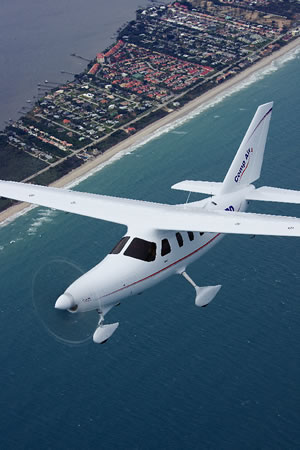
But the CA9 was designed from the start to use a turbine, and a big one at that. The Honeywell TPE331-10, previously known as a Garrett engine, makes 1000 shp at sea level. Its a big-boy powerplant-certified, well-known, extremely durable and blessed with an excellent support network. Drawings of the CA9 were shown at Oshkosh in 2006, but the actual article flew late last year.
Sure, Ill Go!
The message read: Would you consider going to Florida to fly a new airplane, the Comp Air CA9? It was January here in Georgia, the temperatures had been in the teens, my hangar bathroom was shut down to prevent freezing, and the 300-foot walk up the hill to the house, where the bathrooms still work, was getting rather tiring. I guess I could break loose for a day or two.
On January 19, Louise (my RV-4) and I arrived at Merritt Island Florida Airport, where the Comp Air offices are conveniently located just one deck above the FBO. So far this trip was going pretty well. There I met Ron Lueck, president and CEO of Comp Air, and Bill Fedorko, the COO and marketing manager. Lueck is also the designer, builder and chief test pilot for the Comp Air series of aircraft. His beeper gets a lot of action.
Not Your Typical Preflight Briefing
Lueck and I began the preflight briefing by going over the flight-test card. He was agreeable with all the testing I wanted to do until we got to stalls, when he mentioned the aircraft hadn’t yet been stalled. At this point it became apparent this was not going to be a typical KITPLANES flight evaluation.
Let me explain. Normally, we prefer to fly finished (or nearly finished) airplanes that have at least been through the Phase I flight-test portion. Sure, I had flown a number of prototypes, but only after the flight-test program had been completed and the final configuration determined. Its not usually fair to the aircraft design or designer to critique an early version; there are often myriad alterations en route from the original to the marketable design, as there should be. The last thing you want to hear as a kit buyer is that the for-sale product is exactly as it came off the drawing board. Intensive, careful, intelligent development is critical to any airplanes success, whether kit or certified.
But the CA9 was a different story. In this case the designer/president was willing to let us fly his airplane during the flight-test period, and before some major changes were incorporated. It was an offer I couldn’t refuse; after all, every curious test pilot wants to see early examples. But it forces a compromise of sorts: We don’t come out with a firm good/bad, buy/dont buy recommendation after this set of flights. There is simply too much left for Lueck and his staff to do before the airplane should be considered finished.
There’s more to the story. During the flight, Lueck told me I was the only other pilot, besides himself, to fly the CA9-another first in my KITPLANES flight evaluation experience.
OK, back to the flight testing. We continue going over the test card, now modified to delete stalls in any configuration. Lueck had flown the CA9 down to 70 KIAS, so we made that our minimum IAS for the flight and decided to conduct the slow flight section at 80 KIAS. It seemed like a reasonable risk, and Lueck is enthusiastic about the flight qualities hes seen so far.
First Impressions
The CA9 is big. As I walk up to my RV-4, Im looking down on all of it. With the CA9, Im looking up at everything but the wheels, and they’re big, too. The wingspan is 40 feet; the fuselage is 37 feet long and an impressive 13.5 feet tall. The CA9 weighs 3800 pounds empty, against a 7200-pound maximum gross weight. Lets put that in perspective: Comp Airs own CA10 maxes out at 6000 pounds gross, is 6 feet shorter and has slightly less wing (242 square feet versus the CA9s 250). A Cessna Caravan is 4.5 feet longer and slightly lighter empty, but has 400 fewer shaft horsepower. The CA9 towers over a Murphy Moose.
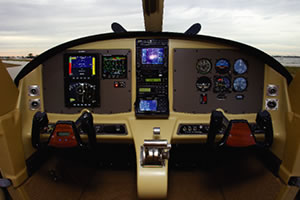
Inside, the CA9 has seats for two pilots and four passengers, plus a baggage compartment aft in the fuselage-obviously smaller than the Caravan, which can carry 10 to 14 individuals in high-density seating. The factory airplane is nicely decked out. It has a door on each side for the pilots, and a sturdy step door right side aft for passengers and cargo loading. The pilot doors each have retractable step ladders that are easily folded prior to closing the door. All doors have inflatable seals, as the CA9 is pressurized. My initial impression of this prototype is a well-finished aircraft showing excellent workmanship.
On the Flight Line
At first glance the CA9 looks like a Cessna Caravan would like to look, slick and slimmed down. You wont build this in your living room, or even a typical GA hangar with 12-foot doors. When one first sees this airplane the term builder assistance immediately comes to mind. Lueck agrees and recommends builder assistance for the kit version of the CA9.
A side view of the airplane shows good balance between the long nose, required by the relatively light turboprop powerplant, and a large, swept back vertical tail with ample rudder area. The horizontal tail span looks matched to the cantilevered high wing, and the ratio of stab to elevator area is reasonable. The moving surfaces of the tail group, with their conventional trimtabs, should provide good control power.
Manually moving the elevator discloses little friction. The rudder has more friction, which is normal, but it isn’t excessive. I wanted to move the ailerons, but they were too high to reach. The landing gear is well-faired. The maingear legs are Grove types, but thicker than your average Cessna legs. The nosewheel is conventional air/oil shock design and steerable.
Climbing In
The retractable steps provide easy entry from either side if the proper foot is used on the first step; otherwise, some leg crossing is required at the top. The pilot seats are comfortable and fully adjustable. The panel is laid out well, with glass displays on the pilots side-a pair of Grand Rapids Technologies displays for flight instruments and an Electronics International MVP-50 engine monitor just to the right-along with an excellent set of full-size backup steam gauges on the copilots panel. In mid-panel were the nav displays, including a Garmin 530 at the top and a portable GPSMAP 496, the only glass stuff I knew how to work, at the bottom. In between is a TruTrak Sorcerer autopilot.
Once in the right seat, I check the controls for friction and motion. The elevator control has little friction and reasonable motion. The aileron control has about 2 to 3 pounds of friction and reasonable motion. Checking the rudder friction and motion have to wait until were airborne due to the nosewheel steering mechanism. Lueck demonstrates a manual start, as the automatic start has not yet been incorporated. Even a manual start is pretty much a non-event, as was taxi.
Takeoff and Climb
Once Lueck completes the checklist, which includes setting the flaps at 20, were ready to go. Full throttle yields an indicated 96% power (the final engine trim not yet completed on the prototype), and Lueck reminds me that the left-hand rotation of this engine requires left rudder to counter torque. OK, Berthe, just think helicopter.
Rotation and liftoff come at 75 knots indicated (KIAS) after about 700 feet of ground roll. The initial climb at 100 KIAS results in a rather high deck angle, so at 1000 feet AGL, we raise the flaps and allow the CA9 to accelerate to 140 KIAS on 85% power. The deck angle is then much more comfortable.
Lueck hands over control on our climb to 6000 feet to get above the low-level clouds for a smoother ride. My first impression of the flight controls is of a typical transport type: There is stiffness in roll with no indication of the aileron friction I noticed on the ground. The large ailerons provide hinge moments that overcome the friction. Here is a bit of a surprise: Pitch forces are lighter than roll forces, and although there is a long period mode, the low short period frequency indicates weak static stability (it is a little soft and sluggish in pitch). The spiral mode proves to be neutral (it holds hands-off bank angles, left and right). The Dutch-roll mode is damped well, with a low roll-to-yaw ratio, and the frequency is moderate; there is good directional stability thanks to that big tail. As would be expected, rudder trim is required for all power changes because of the larger tail being immersed in the propwash.
In general its a good showing, short of the soft static stability. But heres a pleasant surprise: Lueck mentions that he is aware that the pitch stability is weak and has already decided to move the wing aft about 4 inches. I ask, Is that a big problem? He replies, amazingly, that its not. The wing attach points are designed to allow some shifting if required. The reason he hasnt yet stalled the airplane is that he wants to get the CG right first. Good thinking.
Level Off and Cruise
Leveled at 6000 feet MSL, power at 63%, the airspeed scoots up to 185 KIAS, for a calculated 205 KTAS. I have no doubt the 250 KTAS cruise speed predicted for the CA9 is achievable and could probably be exceeded at altitude. Remember that 6000 feet is probably well below the most efficient altitude for the airplane. Fuel consumption will vary by altitude, of course, but CA9 builders ought to plan for between 50 and 60 gph in normal cruise. Comp Air quotes a fuel burn of 35 gph on its web site, which is probably at very high altitude and low power. The airplane is designed to hold 400 gallons of fuel, so even at high cruise the overall endurance is quite good.
There is some difficulty achieving desired pitch trim. Coupling between roll and yaw trim is evident but not obtrusive. The aircraft exhibits speed stability, as there is a long period mode; however, the low short period frequency indicates a low level of static stability for this flight condition. Pitch forces are lower than the roll forces. However, stick force per G was 10 to 15 pounds, which is typical for transport cruise tasks. Adverse yaw is low, roll forces somewhat high; roll damping is excellent, which makes for precise capture of bank angles. Spiral mode proves neutral in both directions. Overall, at cruise, the pilot workload is low, with most of the effort applied to achieving desired pitch trim.
Slow Flight
Slowed to 100 KIAS, we give the CA9 30 of flaps and continue decelerating to 80 KIAS. Maintaining this airspeed requires about 35% power, with some rudder trim needed for any power adjustments. Again, the light pitch forces are quite evident, and achieving desired pitch trim proves difficult. A check for speed stability indicates there is none-the aircraft has neutral static stability. This explains the trim difficulty.
The light pitch forces persuade me not to check for pitch force per G, which requires a sustained 60 bank turn, and I compliment Lueck on his decision not to stall the CA9 at this stage of flight testing. Adverse yaw is moderate at this speed and requires conventional use of rudder coordination with roll inputs. The Dutch-roll mode is somewhat slower than at higher speeds, but well-damped, and maintains a low roll-to-yaw ratio. Again, the spiral mode is neutral, controlling bank angle an easy task.
The lack of speed stability makes basic air work more difficult, with the majority of pilot compensation applied to control airspeed and altitude. An additional workload is the difficulty of making roll inputs, requiring moderated force, without making inadvertent pitch inputs due to the much lighter pitch forces. Looking ahead, I expect a high pilot workload on final approach and landing.
Descent and Landing
The descent is a low-workload event as is entry to the landing pattern. Lueck demonstrates a good approach and solid landing with a short rollout by judicial use of Beta control ground mode of the TPE-331 turboprop engine.
He hands over the airplane on the taxiway. The ground maneuvering of the CA9 is quite easy with use of Beta, and the nosewheel steering gains are set well. I line up on the centerline, slowly apply full power and even remember to use left rudder for torque control.
There is no tendency to overrotate at 75 KIAS; however, with the slight left crosswind I drift right after rotation due to poor planning. The correction is easy, and Lueck doesn’t squirm much. Our downwind extended due to traffic, I have plenty of time to play around some on the long final approach. The light to moderate turbulence doesn’t have much effect due to the CA9 wing loading-28 pounds per square foot at the maximum gross of 7200 pounds. There is some pitch change when the flaps are lowered to 30, but its easily controlled.
I perform a low-gain, non-aggressive final approach and use as much runway as I want; even so, Im able to make a smooth touchdown somewhere near the centerline. Had we much of a crosswind, or had I tried to land on a precise spot, things would not have gone as smoothly. At the parking area Lueck demonstrates his technique for backing into the parking spot. I love turboprops!
Overall Impressions
I like this airplane. It is well thought out and constructed. The Honeywell TPE331-10 is a proven powerplant and is intuitive to operate. The cockpit and cabin are roomy, and access to either the cockpit or cabin is excellent. The pilots side doors offer easy entry when the cabin is fully loaded in the cargo mode. The CA9 prototype is fully equipped, with cabin pressurization, air conditioning, heating (soon), autopilot and glass panel with all its attendant bells and whistles.
Those bells and whistles-not to mention the big whistly thing up front-are not cheap. Comp Air says the kit will cost something less than $1 million. (Were talking about other peoples money here. As I blithely write these numbers, I cant help but remember that my RV-3 cost $10,000 in 1984.)
Still, there is much work to be done. The loading for this flight positioned the CG as far forward as possible (two pilots, 75% fuel and no passengers or baggage). However, the flight demonstrated reduced longitudinal static stability in cruise, and neutral longitudinal stability in slow flight and when landing. This put the CG slightly aft of what I would consider to be an acceptable aft limit. What is desired is for the CG to be slightly forward of the aft limit when the airplane is fully loaded and at max gross weight.
None of this comes as a surprise to Lueck. He was already aware of the problem and has a way to fix it, as hes done it with other Comp Air aircraft. He designed the CA9 to allow a more aft location of the wing if required. A designer whos also the builder thinks of things like this. I look forward to revisiting the CA9 at the end of the flight-test program. And Im grateful to Ron Lueck and the Comp Air staff for giving me the opportunity to fly his work in progress.
For more information, call 321/452-7168, or visit Comp Air.
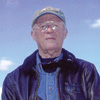
![]()
Chuck Berthe is a retired Naval aviator, civilian test pilot, and aeronautical engineer, with ATP, CIFI, Helo, A&P ratings and two Repairman Certificates. He has logged 1660 pilot hours, and is an Associate Fellow in the Society of Experimental Test Pilots.

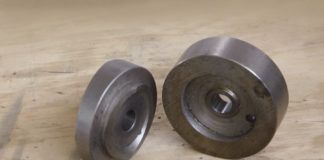
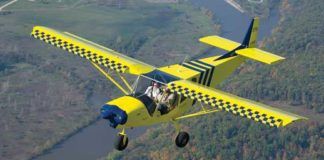
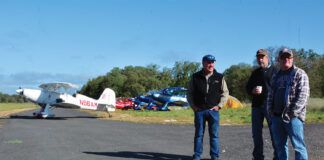

Dear Chuck Berthe,
Would like to know your opinion Comp air 9 , after reading through your right up, are they a safe plane , would it be useful doing country work on large Rural Properties here in Australia. Is it a one Pilot aircraft ? or it can have 2 pilots, does it have a high ceiling of flight to take advantage of the large Turbo Prop, if any other good things it has please let me know, can you tell me how to contact these people, one more Question do they fully assemble these aircraft. and are they still in Buisness.
Regards Trevor.W.Bacelli.